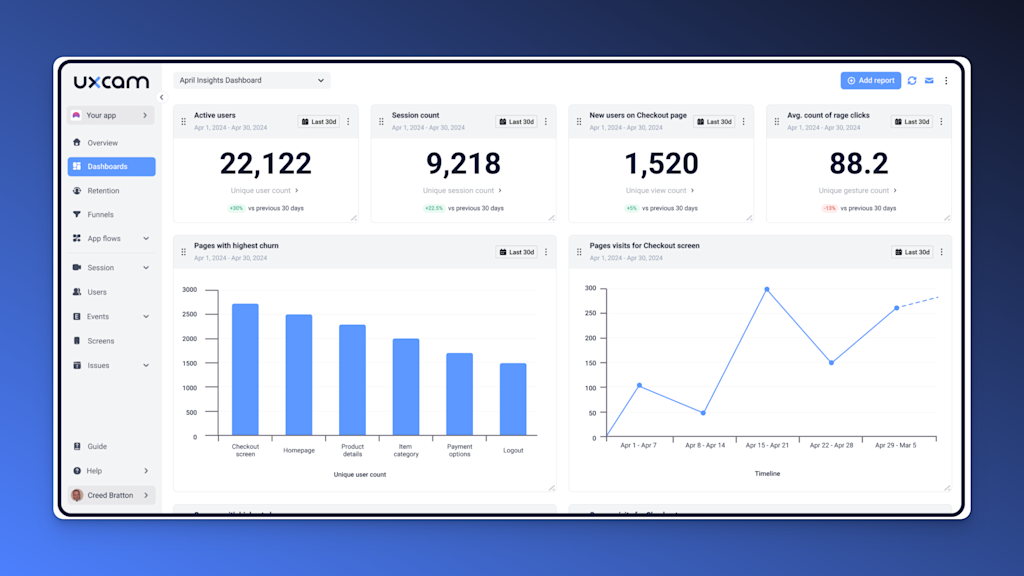Back to blog
7 MIN READ
How to Find Unique Monthly Visitors For a Website
PUBLISHED
29 April, 2025

Product Analytics Expert
You're in a boardroom, quarterly growth review underway. First slide? Unique Monthly Visitors. Always.
Leadership wants to know: How big is the top of our funnel? Is traffic growing? Are we acquiring the right users? All roads lead back to one metric, unique monthly visitors.
But here's the catch: most teams misreport it. They confuse sessions, pageviews, and visitors. That’s how product roadmaps go sideways and marketing spends get questioned.
I've been there. Burned by the wrong number on the wrong slide. That's why it's critical to know how to find unique monthly visitors for a website, the right way.
In this article, I’ll walk you through proven methods, trade-offs, and practical tools, how to use UXCam for Web to get accurate, actionable visitor data that drives decisions. No fluff. Just what works when you’re on the hook for growth.
What are unique monthly visitors?
Unique monthly visitors are the number of distinct individuals who visit your website at least once in a 30-day period. They're typically tracked using user IDs, cookies, or device fingerprints—not raw pageviews or sessions.
Think of it as your website’s true audience size. Whether someone visits once or 50 times in a month, they only count as one unique visitor.
It’s different from sessions (which count every visit), pageviews (every click), or even MAU (which often includes app users, too). Related terms include active users, daily unique visitors, and repeat visitors—but each means something slightly different.
But here’s where it gets tricky. Identifying a “unique” visitor isn’t always straightforward.
Some users block cookies. Others switch devices mid-journey. And with privacy tools and ad blockers becoming standard, tracking accuracy drops fast.
That’s why getting UMV right requires more than just turning on Google Analytics. You need to know how your tools define and deduplicate users—and what blind spots to expect.
Why obsess over UMV?
As a product manager, you’re constantly balancing what to build, who to build it for, and when to double down. That starts with knowing who's actually showing up. That’s why unique monthly visitors (UMV) is often the first metric to look at when evaluating product health.
UMV gives you the clearest signal of top-of-funnel momentum. It tells you if your acquisition channels are working and whether you’re even in front of the right audience.
It also gives you context for activation rates. If 50,000 users visit but only 500 sign up, you don’t have an activation problem, you have a targeting problem. That insight steers your roadmap faster than any funnel slide ever could.
You can also use UMV to measure feature launch impact. A spike in traffic after a release means the messaging hit. A spike with no engagement? That’s a UX fail waiting to be fixed.
And when analyzing retention cohorts, UMV tells you who’s entering the product journey, so you can focus your efforts on keeping the right users, not just any users.
How to find unique monthly visitors (by method)
There’s no one-size-fits-all way to track unique monthly visitors (UMV), but as a product manager, your job is to choose the method that’s accurate enough, fast enough, and actionable enough to support decision-making. Here’s how I’ve approached it over the years.
1. UXCam for Web – Product analytics approach
If you want fast, reliable, and actionable data with zero setup friction, then UXCam is your best bet.


Here’s why:
UXCam auto-tracks UMV, you don’t need to set up events
It captures DOM changes, route transitions (great for SPAs), and full sessions
You get a unified view across web and mobile, tied to actual user behavior
You just add a one-line JS snippet, map your user_id, and your dashboards start populating instantly.
This is the fastest way I’ve seen to go from “how many visited” to “why they didn’t convert.”
When you’re balancing experiments, feature launches, and weekly OKRs, speed matters and UXCam gives you both scale and insight.
2. Google Analytics 4 (GA4)
Use this if you need a quick, free way to check top-of-funnel trends.
You’ll find UMV by going to: Reports → Engagement → User activity → “Total Users�”
Set the date range to the last 30 days. That’s your UMV proxy.
To improve accuracy:
Enable User-ID tracking to stitch logged-in traffic across devices
Watch out for sampling issues and ad-blockers, which GA4 often struggles with
Use BigQuery exports if you need deduplication or advanced filtering
GA4 is solid for high-level volume checks, but lacks qualitative context—especially for SPAs or logged-out traffic.
3. Server-Side or First-Party Log-Based Methods
This is my go-to when you’re working with a CDP or your data team owns a warehouse.
You’d group logs by
, apply a rolling 30-day window, and count distinct values. This works great if:You own identity management across devices
You need precise, privacy-compliant reporting
You want to merge traffic from multiple sources (web, app, API)
Best practices:
Filter out bots, internal IPs, and QA traffic
Deduplicate using hashed identifiers, not cookies
Make sure your date logic handles time zones consistently
Great accuracy, but resource-heavy. It’s not ideal for fast iteration.
Step-by-Step: How to track unique monthly visitors with UXCam
With UXCam for Web, tracking unique monthly visitors (UMV) is not just easy—it’s built into the flow of how product teams work. Here’s how I’ve done it across multiple launches and platform rollouts.
1. Add the 1-line JS snippet - Start by copying the tracking snippet from your UXCam dashboard and drop it into your site’s <head>. That’s it, no manual tagging required.
2. Configure user identity mapping - In UXCam settings, map your user_id, hashed email, or login token to enable cross-device identity resolution. This ensures visitors aren’t double-counted across browsers or devices.
3. Navigate to Dashboards → Add Report → Metric → Unique Users Build a new card that shows UMV at a glance. Set the metric to “Unique Users” and give it a name like "UMV – Web (30 Days)".
4. Set your time window to rolling 30 days - This aligns with how most execs and marketing teams measure monthly performance.
5. Apply segmentation filters - Split UMV by new vs. returning users, mobile vs. desktop, or by source (e.g., organic, paid, referral). This gives you context, not just a raw number.
6. Link UMV to session replays and heatmaps - Click into any UMV segment to watch session replays, analyze click paths, or explore heatmaps. That’s where you’ll find drop-off causes, friction points, and feature blind spots.
Pro Tip: After a major release, set up a Slack alert in UXCam to notify you if UMV drops by more than 5% week-over-week. We’ve caught issues like broken forms and slow pages before users reported them.
Actionable tips to improve UMV accuracy and reliability
Your UMV is only as good as your tracking hygiene. Here’s what I’ve learned (sometimes the hard way):
Sync user identity across platforms (web, mobile, backend) so you don’t count the same person twice
Use first-party cookies for longevity and fallback to fingerprinting when identity is unknown
Filter out bots, internal IPs, and test environments—otherwise your own team will inflate the numbers
Track single-page apps (SPAs) properly using route change detection or auto-capture from UXCam
Always segment before reporting—a single UMV number is meaningless without knowing who those visitors are
Common mistakes PMs Make (and How to avoid them)
Let’s get real—UMV data can mislead you if you don’t watch out for these traps:
Mistaking sessions for users: Sessions can double-count frequent visitors. UMV tells you how many people came, not how many times they came.
Not deduplicating across domains/devices: If your site uses multiple subdomains or platforms, inconsistent tracking will inflate your numbers.
Forgetting to exclude internal/test traffic: Your team should never appear in your UMV count. Ever.
Over-relying on GA4: GA4 is useful, but product-level insights require deeper behavioral context—this is where UXCam excels.
Failing to track engagement quality: A spike in UMV means little if bounce rate or rage clicks also spike. Track what visitors do, not just that they showed up.
Beyond the Count: Turning UMV into product strategy
Tracking unique monthly visitors is step one. But if you're only using UMV to measure traffic volume, you're missing the real value. As a product manager, your job is to ask: what does this traffic actually tell me about the product?
Start by tying UMV to feature launches. A spike in visitors after release? That tells you marketing landed. But if activation doesn't follow, you’ve likely over-promised or under-delivered on value.
Use UMV to monitor top-of-funnel health. Consistent growth means your acquisition channels are alive. Sudden drops? Time to check for outages, SEO dips, or campaign fatigue.
Most importantly, overlay UMV on your activation journey. If thousands are visiting but not signing up, you’ve got friction in your first-touch experience. That’s a product problem, not just a traffic issue.
Here’s how to use UMV for discovery work:
Who’s visiting but not converting?
Where are they exiting?
What features or content are they skipping entirely?
Advanced UMV use cases with UXCam
UXCam takes your UMV data and turns it into why-level insight. Some of the most valuable things I’ve done include:
Funnel overlays: Layer UMV data onto conversion funnels to spot drop-offs in context
Session replay: Watch what high-bounce visitors actually do before they leave
Heatmaps by cohort: Filter by visitors with <30s dwell time to pinpoint what isn’t catching attention
Behavior-based alerts: Trigger Slack or email alerts when UMV drops—especially after new releases
Cohort comparisons: See how different UMV groups (paid vs organic, mobile vs desktop) engage with new features
These tools help you move from "how many showed up?” to "why didn’t they stay?”
Conclusion
It’s not about how many visitors land on your site. It’s about why they behave the way they do once they’re there. That’s the difference between traffic and insight—and that’s where product decisions live.
As a product manager, you need real-time, user-level context, not just charts on a dashboard. UMV gets you in the room, but tools like UXCam for Web help you ask the right questions once you’re there.
Try UXCam for free today and create your first UMV dashboard in under 10 minutes. You’ll see what your numbers really mean—and start building smarter, faster.
You might also be interested in there;
14 Website Analytics Metrics to Track for Product Teams
SaaS Customer Journey Mapping - A Comprehensive Guide
Website Conversion Funnel - A Guide to Build & Optimize One
Top 14 SaaS Product Usage Metrics and How to Improve Them
What is a Website Conversion? & 16 Strategies to Improve It
Best Product Analytics Software
How to Record User Behavior on Websites (and Why It Matters)
AUTHOR

Tope Longe
Product Analytics Expert
Ardent technophile exploring the world of mobile app product management at UXCam.
What’s UXCam?
Related articles
Website Analysis
What is Web Analytics? Definition, Metrics & Best Practices
Discover what web analytics is, its definition, key examples, and the best tools to optimize your website's performance and user...

Tope Longe
Product Analytics Expert
Website Analysis
Website Heatmap - Ultimate Guide and Best Tools [2026]
Read the ultimate 2026 guide to website heatmaps: discover types, implementation, and the best heatmap tools to optimize user experience and site's...

Jonas Kurzweg
Product Analytics Expert
Website Analysis
Website Analysis - The Ultimate Guide 2025
Website analysis guide: Discover actionable tips to analyze and optimize your site for peak efficiency and user satisfaction. Ready to elevate your web...

Jonas Kurzweg
Product Analytics Expert
